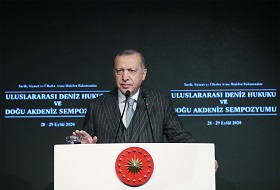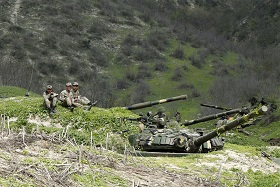The return of violence in Nagorno-Karabakh, a mountainous territory that has been disputed between Azerbaijan and Armenia for several centuries, raises the fundamental question of what the belligerents' expectations are and what diplomatic and military means they have at their disposal to impose themselves on the ground.
In Soviet times, Nagorno-Karabakh was an autonomous oblast with a mixed population — Armenians and Azeris — within the Azerbaijan Soviet Socialist Republic. This affiliation, far from being the outcome of consultation between Yerevan and Baku, was imposed by Moscow in order to divide the peoples of the South Caucasus to rule them better.
Baku, for fear of losing control over the Nagorno-Karabakh oblast, was ready to grant many concessions to the Kremlin. Similarly, Yerevan did not fail to adopt a conciliatory attitude towards Moscow during the Cold War in the hope of one day regaining control over this territory.
As for the inhabitants of Nagorno-Karabakh, identity affiliation to one country or another depended essentially on ethnicity, which led to sporadic and recurrent tensions in the region.
With the introduction of glasnost and perestroika by Mikhail Gorbachev at the end of the 1980s, Armenians and Azerbaijanis began to express themselves more freely and to oppose each other over the legitimacy of governing this area. As mentioned in a 1988 CIA report "Unrest in the Caucasus and the Challenge of Nationalist" (declassified in 1999), Moscow was unable to reach an agreement between Azerbaijanis and Armenians, and had no alternative but to send troops to the region to stop the violence.
After 1991, as the USSR disintegrated, Armenians and Azerbaijanis clashed and the troops of Armenia-backed Nagorno-Karabakh managed to dominate Nagorno-Karabakh and expelled the Azeri populations who found refuge in the rest of Azerbaijan.
Russia sells arms to the two protagonists and has the Collective Security Treaty Organization (CSTO) with Yerevan that ensures military intervention by Moscow in the event of an attack on Armenian territory. Trade agreements, participation in the Eurasian Economic Union, the CSTO does not apply to Nagorno-Karabakh and Moscow is absent and has no diplomatic or military representation. Unlike Abkhazia, South Ossetia or Transnistria, the Kremlin does not take a position and remains neutral without proposing any concrete solution other than the application of a ceasefire.
The United States has an ambiguous attitude, even going so far as to avoid referring to international law in its statements to the OSCE. To date, it is more than 10 American states that recognise Nagorno-Karabakh as an independent country, making the debate difficult for Washington, which prefers to avoid pronouncing itself on the question so as not to offend Turkey within NATO and the Armenian diaspora in the United States.
France, like the European Union, mentions international law and recalls the membership of Nagorno-Karabakh to Azerbaijan. However, Paris does not fail to take into account the reality on the ground and the need to find a solution between the protagonists and above all, without violence.
The recent events of September 2020 make the members of the Minsk Group fear possible interference from Turkey, which is problematic for both the West and Russia. Indeed, Russia does not want a military confrontation with Turkey, which is a member of NATO, and the United States and France do not support Ankara in its pro-Azeri stance.
Ankara recalls its closeness to Azerbaijan and the principle of 'one nation, two countries' which drives bilateral relations. Turkey is more assertive than it was during the Cold War and supports Baku, even going so far as to propose military interference, which was already the case in 1991–1994 with Turkish officers sent to train and support Azerbaijani troops.
For Turkey, it is a question of supporting an allied country, of showing solidarity with a Muslim country, and of confirming Turkish regional ambitions in the Middle East and the Black Sea. If Turkey intervenes militarily, the only two possible options will be to leave Nagorno-Karabakh to the Azeris or else a military intervention by Russia to support Armenia in its actions in Nagorno-Karabakh, as the Westerners do not want to risk interfering.
The return of violence in Nagorno-Karabakh, a mountainous territory that has been disputed between Azerbaijan and Armenia for several centuries, raises the fundamental question of what the belligerents' expectations are and what diplomatic and military means they have at their disposal to impose themselves on the ground.
In Soviet times, Nagorno-Karabakh was an autonomous oblast with a mixed population — Armenians and Azeris — within the Azerbaijan Soviet Socialist Republic. This affiliation, far from being the outcome of consultation between Yerevan and Baku, was imposed by Moscow in order to divide the peoples of the South Caucasus to rule them better.
Baku, for fear of losing control over the Nagorno-Karabakh oblast, was ready to grant many concessions to the Kremlin. Similarly, Yerevan did not fail to adopt a conciliatory attitude towards Moscow during the Cold War in the hope of one day regaining control over this territory. As for the inhabitants of Nagorno-Karabakh, identity affiliation to one country or another depended essentially on ethnicity, which led to sporadic and recurrent tensions in the region.
With the introduction of glasnost and perestroika by Mikhail Gorbachev at the end of the 1980s, Armenians and Azerbaijanis began to express themselves more freely and to oppose each other over the legitimacy of governing this area. As mentioned in a 1988 CIA report "Unrest in the Caucasus and the Challenge of Nationalist" (declassified in 1999), Moscow was unable to reach an agreement between Azerbaijanis and Armenians, and had no alternative but to send troops to the region to stop the violence.
After 1991, as the USSR disintegrated, Armenians and Azerbaijanis clashed and the troops of Armenia-backed Nagorno-Karabakh managed to dominate Nagorno-Karabakh and expelled the Azeri populations who found refuge in the rest of Azerbaijan.
Diplomatic Strategy of Armenia and Nagorno-Karabakh
Since the 1994 victory, Armenia has been trying to have Nagorno-Karabakh recognised as an autonomous country under the Montevideo Convention, without success to date, except for territories that are themselves partially recognised, such as Abkhazia and South Ossetia. Armenian diplomacy is active with the diaspora, particularly in the United States and Australia, and to date, it is more than 10 American states — California, Georgia, Hawaii, Louisiana, Maine, Massachusetts, Michigan, Rhode Island, Colorado and Minnesota — which have recognised Artsakh (another name given to Nagorno-Karabakh), although for Washington the region remains de jure in Azerbaijan.
Yerevan's strategy is to achieve recognition of the territory as an independent country in order to hold a referendum on the incorporation of Nagorno-Karabakh into Armenia. Therefore, for Nagorno-Karabakh, it is a question of surviving the time of a diplomatic recognition which will ultimately lead to its reattachment.
Because of financial difficulties and poor relations with Turkey since the events of 1915, Yerevan is strengthening its partnerships with Moscow, which is the only power capable of imposing itself against Turkey (a member of NATO). Yerevan is a member of the Collective Security Treaty Organization (CSTO) and the Eurasian Economic Union, and as such relies on Moscow's support to preserve its territorial integrity. However, Russia made it clear that its agreements did not extend to Nagorno-Karabakh.
Armenian Armed Forces
With 51 500 men and an annual budget of $634 million, the Armenian forces depend largely on Soviet equipment, good knowledge of the terrain and mastery of guerrilla techniques. The land forces consist of T-80, T-72, T-54/55 tanks and armoured personnel carriers dating back to the Soviet era, including BTR-60s. The AK-74 rifle is a standard in the armed forces. The air force has a mobile multi-channel ground-to-air missile system S-300, 9K33 Osa, S-75 Dvina, 2K11 Krug, Strela10, 2K12 Kub and ZSU-23-4.
In addition, Sukhoi Su-30, Su-25, Mil Mi-8 and Mil Mi-24 helicopters are available with Ilyushin Il-76 for troop transport and Czechoslovak Aero L-39 for training. The other pieces of equipment present, such as the Mi-2, are of little relevance.
Armed Forces of Nagorno-Karabakh
20 000 men, interoperability with Armenian forces and a guerrilla strategy similar to that of the Afghans against American and Soviet troops. Although they have few resources, they have T-72 and T-55 tanks, a large number of armoured personnel carriers such as the BTR-80, and above all affordable artillery and rocket launchers that can hold out against Azerbaijan in the event of an attack. Some reports also mention the presence of Chinese-designed WM-80 MRLs.
The importance of snipers and good knowledge of the terrain, the psychological motivation of the troops and the pragmatism of the soldiers should be highlighted. It is thus customary to take over the opponent's equipment, repair it and then use it against them afterwards.
Azerbaijan's Politico-Military Approach
Azerbaijan wishes to regain control over its territory in accordance with international law. According to Baku, a debate on the autonomy of the region is conceivable provided that the Azerbaijani refugees can also vote in the referendum. This rhetoric is combined with the strengthening of the armed forces which aims to allow the territory to be regained by force, which seems to be the most realistic prospect for Baku because Yerevan and Stepanakert are refusing to accept any possibility of the return of the land within Azerbaijan to date. The sale of hydrocarbons gives a considerable financial advantage to the Azeris who can upgrade their military equipment with drones from Israel, Russian fighter planes and various equipment from several countries.
Baku can count on the diplomatic and military support of Turkey since the fall of the USSR. The objective for Ankara is to support an allied country in the region but also to show solidarity with the Muslim world. In this respect, Nagorno-Karabagh has the appearance of a holy war and it is customary to note the presence of Chechen and Syrian mercenaries, and members of the Hezb-e-Islami Gulbuddin alongside the Azeris. As a member of NATO, Turkey's approach which favours Azerbaijan is badly perceived because it could lead to a conflict between NATO and Russia, a threat already mentioned by the CIA in its 1988 report and which worries the White House.
Azerbaijani Armed Forces
With 66,000 men for $2.2 billion of the annual budget, the Azerbaijanis have at their disposal modern equipment with the ambition to carry out a military intervention in Nagorno-Karabakh.
This includes land forces with T-90s, T-72 and T-55 tanks, as well as troop transport with BMP-3, BMP-2, BMP-1, BTR80A, 82A, BTR-70, BTR0-60, BTR-3. A long list of armoured cars from Israel, such as the AIL Abir, South Africa, such as the Matador, Germany (Mercedes), Great Britain (Land Rover) and the United States are also in that list.
It can be seen that the upgrading brings together a set of equipment from various sources which attests to a strategy that aims to establish diplomatic relations with the purchase of military equipment. Baku seems to favour the rapid movement of troops, which seems logical insofar as Azeri strategy is to advance in the territory rather than occupy a stationary position. Several missiles and launchers from Israel such as LORA, Lynx, EXTRA but also from the USSR and Czechoslovakia, including the RM-70 are deployed. Anti-tank systems are numerous with France's MILAN and South Korea's LIG Nex1 AT-1K. Presence of American FIM-92 Stinger.
As for the air force (with more than 12 000 men), fighter aircraft are all from Russia and the USSR, with MiG-29, Sukhoi Su-25 and MiG-21. In addition, there are Russian helicopters — Mil Mi-24, Mil Mi-17 and Kamov Ka-27 — as well as American Bell 412s. Italian Aermacchi M-346s and Czechoslovakian Aero L-29s and L-39s are used for training.
The air force is not Baku's strong point — with the exception of the drones — which is banking above all on the physical occupation of the ground with the reconquest of Nagorno-Karabakh. As such, the objective is to locate, monitor and destroy ground equipment in order to advance more rapidly. There are drones, all from Israel — Hermes 450 and 900, IAI Heron, IAI Searcher, Orbiter, Aerostar — which are less expensive than fighter aircraft and more relevant insofar as the Azerbaijan air force will meet little resistance from the Armenian air force. In addition, there are Russian defence systems, including the S-300PMU2, 9K37 Buk-1M, Pechora-2TM, and Igla-S/SA-24 (more than 1000).
Because of its access to the Caspian Sea, the Azerbaijani Navy is developed with ships from the USSR including the Polnochny Class, the Svetlyak Class and the Osa Class, from Turkey such as the Kılıç class (German design), and some small submarines as well as European-designed helicopters such as the Airbus Helicopters H215 and the Sud-Aviation SA.365 Dauphin. Unlike Russia, which has ships in the Caspian Sea capable of sending missiles to the Middle East, as was the case during the conflict in Syria, Azerbaijan is limited to ensuring a military presence in the Caspian Sea without the equipment being able to be used in the Nagorno-Karabakh conflict.
The Approach of the Members of the OSCE Minsk Group (Russia, USA, France)
Russia sells arms to the two protagonists and has the Collective Security Treaty Organization (CSTO) with Yerevan that ensures military intervention by Moscow in the event of an attack on Armenian territory. Trade agreements, participation in the Eurasian Economic Union, the CSTO does not apply to Nagorno-Karabakh and Moscow is absent and has no diplomatic or military representation. Unlike Abkhazia, South Ossetia or Transnistria, the Kremlin does not take a position and remains neutral without proposing any concrete solution other than the application of a ceasefire.
The United States has an ambiguous attitude, even going so far as to avoid referring to international law in its statements to the OSCE. To date, it is more than 10 American states that recognise Nagorno-Karabakh as an independent country, making the debate difficult for Washington, which prefers to avoid pronouncing itself on the question so as not to offend Turkey within NATO and the Armenian diaspora in the United States.
France, like the European Union, mentions international law and recalls the membership of Nagorno-Karabakh to Azerbaijan. However, Paris does not fail to take into account the reality on the ground and the need to find a solution between the protagonists and above all, without violence.
The recent events of September 2020 make the members of the Minsk Group fear possible interference from Turkey, which is problematic for both the West and Russia. Indeed, Russia does not want a military confrontation with Turkey, which is a member of NATO, and the United States and France do not support Ankara in its pro-Azeri stance.
Turkey and the Muslim World
Ankara recalls its closeness to Azerbaijan and the principle of 'one nation, two countries' which drives bilateral relations. Turkey is more assertive than it was during the Cold War and supports Baku, even going so far as to propose military interference, which was already the case in 1991-1994 with Turkish officers sent to train and support Azerbaijani troops.
For Turkey, it is a question of supporting an allied country, of showing solidarity with a Muslim country, and of confirming Turkish regional ambitions in the Middle East and the Black Sea. If Turkey intervenes militarily, the only two possible options will be to leave Nagorno-Karabakh to the Azeris or else a military intervention by Russia to support Armenia in its actions in Nagorno-Karabakh, as the Westerners do not want to risk interfering.
Azerbaijan can count on the sporadic presence of Chechens, often mercenaries, who are used to taking part in this type of conflict, as has been the case in Abkhazia and Syria. Mercenaries from Syria also join the conflict for similar reasons to the Chechens. The presence of Grey Wolves from Turkey, belonging to the extreme right affiliated to the Nationalist Action Party (Milliyetçi Hareket Partisi) and members of the Hezb-e-Islami Gulbuddin (حزب اسلامی گلبدین) from Afghanistan has been noted. While Turkey positions itself on the conflict for geopolitical and strategic reasons, the mercenaries do so mainly for ideological, pecuniary and religious reasons.







